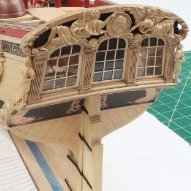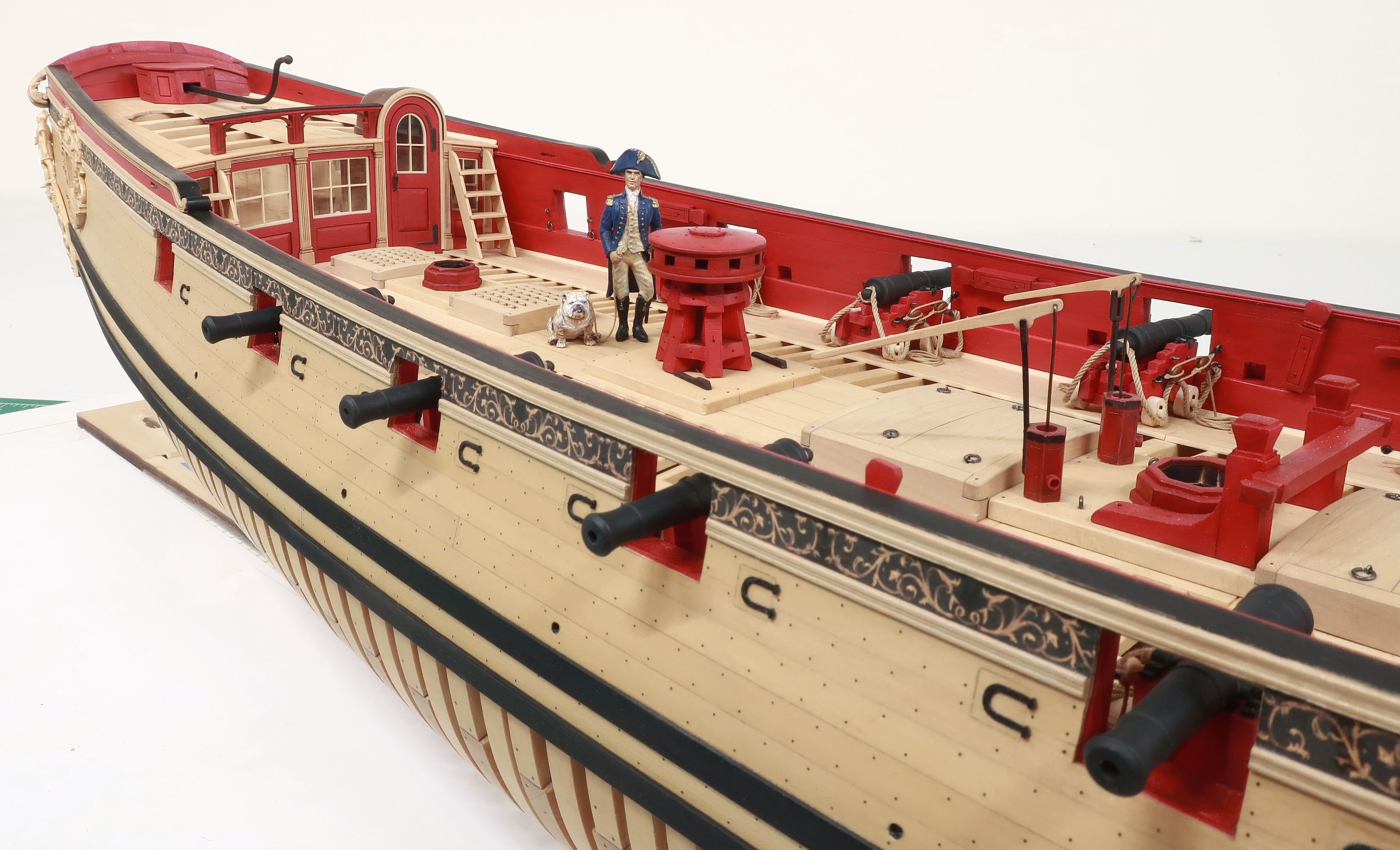-
Posts
9,673 -
Joined
-
Last visited
Content Type
Profiles
Forums
Gallery
Events
Everything posted by Chuck
-
Looks good. Bet you are glad thats finished. Be careful with the poly. You dont want a shiny hull. Wipe it off immediately so you dont get any shiny spots. I would sand the entire hull lightly and reapply. Wiping off any excess so you dont get any hint of a shiny spot.
- 274 replies
-
- Cheerful
- Syren Ship Model Company
-
(and 1 more)
Tagged with:
-
Bob…she is looking good. A quick note… If you plan on rigging the ships wheel, you should drill two holes in those slots on the gundeck. Into the center of each slot. I am talking about that little square just forward of the bulkhead. Then insert two long lengths of rope….025 would do the trick. If you dont do this now you will have a devil of a time getting rope down between the beams. You can wrap the rope around the drum for the ships wheel much later in the project. So just neatly coil it up and set it to the side for now after inserting the ends i nto the holes you drilled.
-
That is some neat and tidy work. Nice tight seams and joints. Well done.
- 99 replies
-
- winchelsea
- Syren Ship Model Company
-
(and 1 more)
Tagged with:
-
Yes you can send folks here by posting a link to a log on MSW.....and yes you can post your stuff anywhere, its yours. This rule simply lets folks know that you cant take photos and logs from other people/members and post them outside of MSW....without asking them for permission first. For example....you cant copy my plans and build log photos for the Medway Longboat group on another forum without first getting permission from me....you shouldnt save any PDF files or chapters created here for such builds on other forums. You cant duplicate or post photos of another members work without asking them first for permission. Its to protect our members....you guys from having your photos and documents stolen without your knowledge or approval. Certainly you can see why that is the case. Chuck
-
Just beautiful Glenn…cant wait to see what you do with the Winnie. The cedar on your Cheerful looks so lovely. chuck
- 778 replies
-
- cheerful
- Syren Ship Model Company
-
(and 1 more)
Tagged with:
-
Well done on the square tuck!!
- 274 replies
-
- Cheerful
- Syren Ship Model Company
-
(and 1 more)
Tagged with:
-
That is looking nice and tidy. Very nice progress. You have most of the repetitive stuff all done except for the cannons. It should go much easier from this point on.
- 99 replies
-
- winchelsea
- Syren Ship Model Company
-
(and 1 more)
Tagged with:
-
That sure looks pretty. Excellent clean work.
- 185 replies
-
- queen anne barge
- Syren Ship Model Company
-
(and 1 more)
Tagged with:
-

HMS Granado 1742 Kit - CAF Model - 1:48 Scale
Chuck replied to cafmodel's topic in Wood ship model kits
Nice work Tom. Looking pretty good so far. -
That looks great. A really nice longboat model. I am so glad you enjoyed it. Well done.
- 109 replies
-
- medway longboat
- Syren Ship Model Company
-
(and 1 more)
Tagged with:
-
Beautiful. You have done a really nice job with the model. I do hope you enjoyed putting it together.
- 109 replies
-
- medway longboat
- Syren Ship Model Company
-
(and 1 more)
Tagged with:
-
I use Dull coat....or Krylon Matte fixative. I spray from far away....about 2ft. Chuck
- 1,784 replies
-
- winchelsea
- Syren Ship Model Company
-
(and 1 more)
Tagged with:
-
Just a wipe on poly finish. I applied and wiped it off immediately buffing it to a dull finish.
- 1,784 replies
-
- winchelsea
- Syren Ship Model Company
-
(and 1 more)
Tagged with:
-
Yes it is correct…just tie it around the mast above the shroud gang. the model looks excellent. Really nice rigging work. Very neat and clean. chuck
- 109 replies
-
- medway longboat
- Syren Ship Model Company
-
(and 1 more)
Tagged with:
-
David We have all been there...I am so glad you are sticking with it. My advice to you is to just slow down. Slow down your building a great deal giving each task much more care and attention. The results will be much better and a pleasant secondary outcome is that you will end up with fewer models in the end which we all know is a big problem. In addition, not trying to move ahead quickly to the next task can be much more enjoyable. Take the time to line off your hull and then only add a couple of strakes each day but done neatly and with care. Take twice as long to build your model and you will end up with half as many models to give away and less you have to convince your kids to take an interest in. Looking forward to following your Speedy project. 😃
About us
Modelshipworld - Advancing Ship Modeling through Research
SSL Secured
Your security is important for us so this Website is SSL-Secured
NRG Mailing Address
Nautical Research Guild
237 South Lincoln Street
Westmont IL, 60559-1917
Model Ship World ® and the MSW logo are Registered Trademarks, and belong to the Nautical Research Guild (United States Patent and Trademark Office: No. 6,929,264 & No. 6,929,274, registered Dec. 20, 2022)
Helpful Links
About the NRG
If you enjoy building ship models that are historically accurate as well as beautiful, then The Nautical Research Guild (NRG) is just right for you.
The Guild is a non-profit educational organization whose mission is to “Advance Ship Modeling Through Research”. We provide support to our members in their efforts to raise the quality of their model ships.
The Nautical Research Guild has published our world-renowned quarterly magazine, The Nautical Research Journal, since 1955. The pages of the Journal are full of articles by accomplished ship modelers who show you how they create those exquisite details on their models, and by maritime historians who show you the correct details to build. The Journal is available in both print and digital editions. Go to the NRG web site (www.thenrg.org) to download a complimentary digital copy of the Journal. The NRG also publishes plan sets, books and compilations of back issues of the Journal and the former Ships in Scale and Model Ship Builder magazines.



